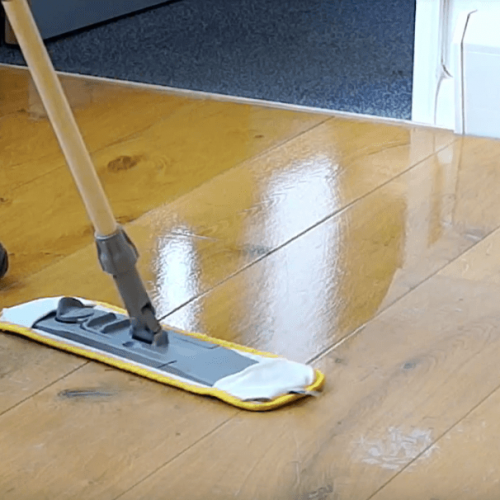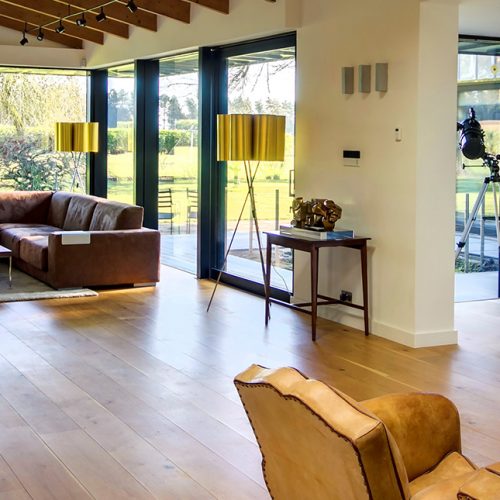One of the benefits of a beautiful wooden floor is the ease of cleaning and maintaining. It’s a flooring solution for your home that will add warmth and character as well as being much easier to keep clean in comparison to carpet.
However, over the years spills and accidents will happen that may cause stains to your floor that you will want to remove. In this article we discuss how to remove wood floor stains and, just as importantly, how to prevent them in the first place.
Prevention is better than cure…
When it comes to stains on a wooden floor, prevention is always better than cure.
This starts by ensuring that your floor is finished with a high-quality product that’s both durable and stain resistant. Once you have a floor in your property that’s treated in such a way, the next most important thing is to look after it. By using the relevant soaps, polishes and maintenance products you will be continually nourishing the surface of your floor keeping the finish as healthy as possible for as long as possible and in turn help maintain its stain resistance.

Do's and Don'ts
Do:
– Think about the nature of where the flooring is being used and choose a finish that suitable. In areas like kitchens, stain resistance is very important and therefore by choosing a quality & suitable finish from the outset you’ve got off to the best start in having a clean and stain free floor for as long as possible.
– Be familiar with what finish is pre-applied / you apply to your floor and maintain the floor with the appropriate cleaning and maintenance products. Generic “safe for wood floors” cleaning products can sometimes cause more harm than good.
Don’t:
– Use steam cleaners to clean your floor. They can cause damage to the board itself and also break down the finish making the floor less stain resistant in time.
– Use harsh detergents or chemicals. They can also break down the finish on your floor.
– Use excessive water when cleaning your floor. A damp, not wet, mop / cloth should be used.
Accidents do happen and acting fast is key...
Generally speaking you know when accidents occur and acting fast is key. If your floor is treated with a high-quality, stain resistant finish the majority of spills will not stain if mopped up in a reasonble time.
The quicker you manage to clean up the accident, the less time the substance has to penetrate the timber, making it far less likely to leave an unwanted mark on your timber floor. The same applies with water – if your floor is to be laid in an area where water is likely to be splashed over the surface, such as bathrooms (not all wooden flooring is suitable for bathrooms), then dry the floor as soon as possible.
Identify the type of stain
How to remove a stain from your wooden floor...
There is no set way of removing a stain from a wooden floor. The manner in which you deal with the stain will depend on the type of stain in question and the finish that your flooring has applied to it.
Surface stains:
If the stain has come from a food or drink spillage it’s likely to have not penetrated too far into the floor and therefore a good place to start is by simply using warm water and the relevant floor soap to try and remove the stain.
Deeper stains:
However, if the above doesn’t work or if the stain is darker in colour this may be a sign that it’s penetrated deeper into the timber itself.
There are products out there that can work to remove stains from timber such as Hydrogen Peroxide or Oxalic acid, however you need to be very careful in doing so as these are bleaching agents and can result in changing the nature of the stain or pulling the colour out of the floor.
If you are struggling to remove the stain in your floor, then this method can be attempted but we would recommend trying it first on a sample piece or in an area of the floor that can’t be seen (under a counter, in a cupboard etc) to see the effect it has.
If your flooring has been down a while and there are areas that have start to go darker in colour (often around doorways / entrances from outside), this may be because the finish has worn very thin in these areas. It’s likely that water has got to the timber itself that’s reacted with the tannin in the oak, causing a darker stain within the floor. These will usually require sanding to rectify.
Sanding
As a last resort, when all else fails, you will need to sand the stained area of your floor. This is a good time to assess the overall condition of your floor. If your flooring is an old floor, it may pay you sand the whole floor back and re-treat entirely – bringing the flooring back to a like new condition.
If you feel as though the flooring as whole is looking fine, but it’s just a local area that has been affected, you must know what the floor is treated with. You need to keep in mind that you will also be sanding off the finish that has been applied and therefore, once sanded, the area in question will need to be re-treated with the same product to visually tie in with the rest of the floor as best as possible. This can be tricky if your flooring came pre-treated. Try and get as much information as possible from the supplier to establish what finish you need to be using to achieve this.
One of the advantages of treating a floor on-site yourself (purchasing an untreated board in the first place) is you will always know exactly what product you used at the time and can treat with the same product, using the same method, again.

“When sanding an area of your floor, sand back boards in their entirety, rather than just half way up the board. If you do this, then carefully retreat the effected boards, then any slight variation in the re-finished area is more likely to look like natural variation from board to board.”
Tom Fanthorpe, Director @ JFJ Wood Flooring
How to remove wood floor stains – Other related articles:
